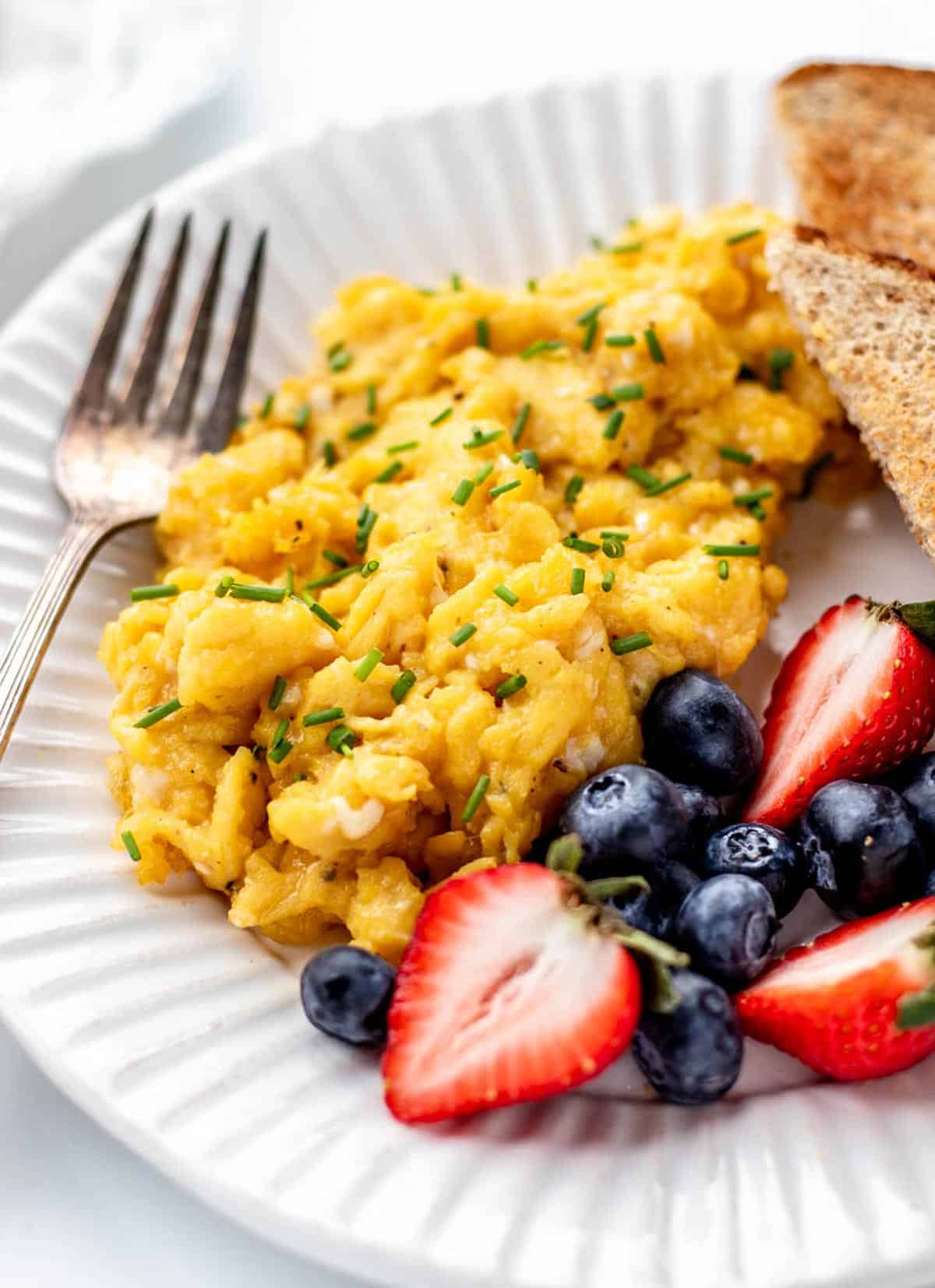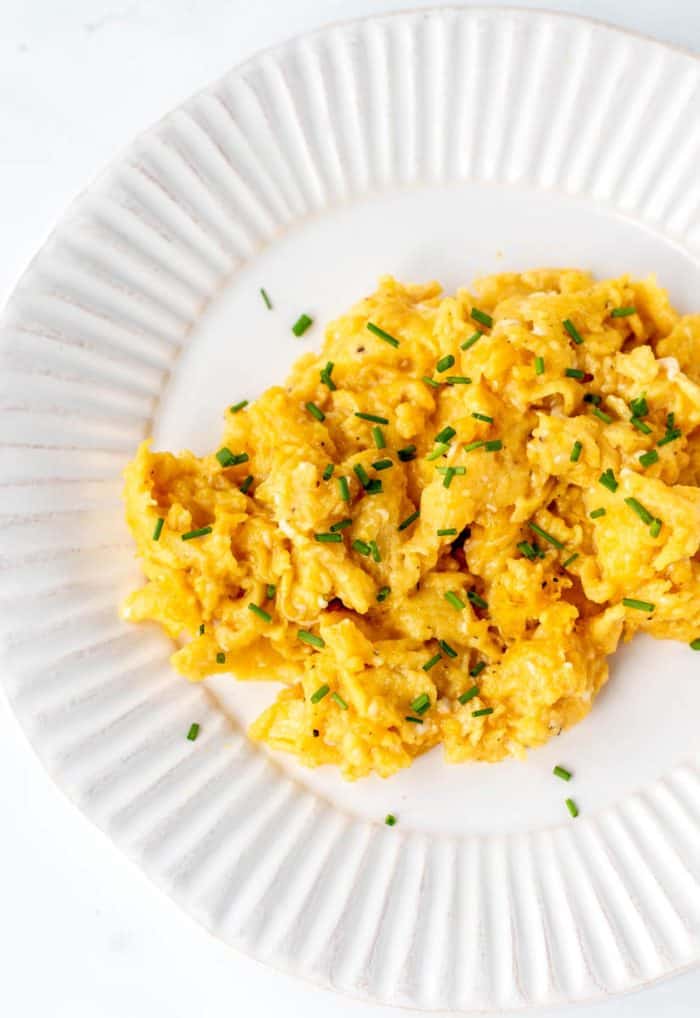Learn how to make soft and creamy scrambled eggs without milk or cream! These delicious eggs are perfectly light, fluffy and so easy to make. The perfect protein-packed option for any meal of the day! {Dairy-free, gluten-free & vegetarian}

Soft & Creamy Scrambled Eggs – No Milk or Cream!
Did you know that you can make extra creamy scrambled eggs without milk or heavy cream? That’s right! The secret is all in the cooking technique.
When cooking scrambled eggs, you need to be patient, cook them low and slow and continuously move the eggs while they’re cooking in the frying pan to achieve a creamy texture and prevent them from overcooking and drying out.
Prior to cooking the eggs, it’s also highly recommended that you use a whisk to add air and height to the eggs.
Once you try this recipe out a few times and follow our simple tips, you’ll become a pro at cooking the ultimate light and fluffy scrambled eggs!
For more easy egg recipes, try out these Spinach Zucchini Frittata Fingers or Mini Egg Bites!

Benefits of Scrambled Eggs
- Highly nutritious: Eggs are packed with important nutrients like iron, phosphorus, selenium and vitamins A, B12, B2 and B5. They’re also an excellent source of protein.
- Helpful for brain development: Eggs are especially healthy for growing bodies. Egg yolks contain choline which helps with brain function and memory.
- Economical source of protein: With rising food costs, scrambled eggs are an easy choice for a quick source of protein. One serving of eggs contains 11 grams of protein.
Ingredient Notes

- Eggs: Use brown or white eggs as they have the same nutritional value. Four large eggs are used for 2 servings of soft scrambled eggs.
- Salt and Pepper: To enhance the flavour of these scrambled eggs, use a pinch of salt and black pepper. You can adjust the amount of salt and pepper, to taste.
- Olive oil: To prevent the eggs from sticking to the bottom of the pan, they’re cooked in a small amount of olive oil. A little butter, canola or vegetable oil can also be used.
How to Make Fluffy Scrambled Eggs without Milk – Step by Step




- In a 10-inch nonstick skillet, heat butter or olive oil over medium-low heat.
- Meanwhile, in a small mixing bowl, whisk eggs, salt and pepper vigorously until foamy and well mixed.
- Once the pan is fully heated, pour the beaten eggs into the pan and use a rubber spatula to stir the eggs in a circular motion. Keep stirring in circles until soft curds begin to form and the eggs begin to thicken.
- After the eggs have thickened, begin to push the egg mixture back and forth across the pan. Keep pushing back and forth to the edge of the pan until larger egg curds start to form and the liquid is almost gone.
- Remove pan from heat source and let the eggs continue to cook in the residual heat of the pan for about a minute.
- Gently give the scrambled eggs a few folds with the spatula. Then, gently remove the creamy scrambled eggs to a plate and top with chives if desired. Serve warm.
Keep scrolling to the recipe card below for the full printable scrambled eggs recipe!
Tips for the Best Scrambled Eggs
- For fluffier eggs, skip the fork and instead use a whisk to combine the eggs together really well until the mixture is uniform. Using a whisk adds air to the eggs, making them extra fluffy.
- For creamy eggs, don’t overcook the eggs or cook them over too high of a heat setting since they’ll turn out more crusty around the edges rather than creamy. Cook them low and slow for the creamiest and fluffiest eggs.
- Take the eggs off the heat just before they’re fully cooked to take into account the carry over cooking that occurs. The eggs will still continue to cook as long as they’re in the hot pan.
- For best results, use a rubber spatula to move around the egg mixture as it makes it easier to swirl them around without damaging the pan.
- Move the eggs frequently in the pan to prevent them from sticking, which can result in crusty and dry eggs.
- How cooked you like your eggs is completely a personal preference. Perfect scrambled eggs should have a bit of moisture, but should not be completely wet. If they still have quite a bit of extra liquid, turn off the heat and cover the pan for an extra minute or so. The most important thing is that you don’t overcook them to the point where they’re dry and brown.

Recipe FAQs
Yes! Delicious scrambled eggs can be made without milk. Typically milk is added to extend the amount of scrambled eggs when cooking. However, milk is unnecessary because it adds extra moisture and dilutes the flavour of the eggs.
The secret to fluffy eggs is using the right technique to cook them. The most important thing to remember is that you whisk them vigorously to add more air and height, and cook them gently over medium low heat to help maintain that fluffy texture and prevent them from getting overcooked.
Yes, leftover scrambled eggs can be stored in the fridge for 3-4 days. Eggs must be reheated to 165 degrees F before serving. Never leave eggs out for more than 2 hours at room temperature.
Yes, scrambled eggs can be reheated. To reheat scrambled eggs, reheat them on a plate in the microwave in 20-30 second intervals, stirring between intervals to heat evenly. Check them frequently and be careful that you don’t reheat them for too long as they may get overcooked and turn out dry and rubbery.
Storage Guidelines
Store scrambled eggs in an airtight container or cover them tightly with plastic wrap to avoid excess moisture getting in the cooked eggs. They can be stored in the fridge for up to 3-4 days.
What to Add to Scrambled Eggs
Although tasty as is, you can further enhance these scrambled eggs without milk with a number of different add-ins:
Feel free to experiment with any of the following:
- Shredded cheese such as cheddar, gruyere, Swiss, feta, cream cheese, mozzarella, or Monterey Jack
- Add a tablespoon of Greek yogurt for extra protein and creaminess
- A sprinkle of onion powder or garlic powder
- Sauteed onions or shallots
- Sauteed bell pepper or jalapenos
- Sauteed spinach and parmesan cheese
- Fresh herbs like oregano, tarragon, or thyme
- Crispy bacon bits
Serving Suggestions
There are lots of ways to serve up this healthy scrambled egg recipe for a complete and delicious breakfast!
Try them with:
- Healthy Oatmeal Waffles
- 5-Ingredient Bagels or Protein Bagels
- Strawberry Banana Smoothie Without Yogurt
- Creamy Oatmeal
- Healthy Roasted Potatoes
- Healthy Oatmeal Muffins
- Chocolate Peanut Butter Overnight oats
- Avocado toast
- Bacon or sausage
- Fresh fruit bowl and Greek yogurt (or try this Yogurt Fruit Dip)
- Add them to a homemade breakfast burrito
Recipe Variations
- To make lower sodium: Use half the amount of salt or omit the salt altogether.
- To make cheesy: Fold in shredded or grated cheese of your choice. Cheddar, parmesan, Swiss, or goat cheese all work great.
- To add a kick of spice: Add a dash of dried red pepper flakes or cayenne pepper along with the salt and pepper or a drizzle of hot sauce after cooking.

More Tasty Egg Recipes
- Crustless Mini Quiche Recipe
- Muffin Tin Eggs
- Heart-Shaped Eggs
- Crustless Asparagus Quiche
- Healthy Breakfast Sandwiches
- Healthy Breakfast Burritos
- Turkey Sausage Egg Muffins
Did you make this recipe? Scroll down to leave a star rating and review!

Creamy Scrambled Eggs without Milk
Ingredients
- 4 large eggs
- 1/4 teaspoon salt
- 1/8 teaspoon pepper
- 1 tablespoon light olive oil or butter
For garnish:
- Finely chopped fresh chives
Instructions
- Heat oil or butter in a 10-inch nonstick skillet over medium-low heat.
- In a medium bowl, use a whisk to vigorously beat the eggs with salt and pepper until combined and frothy.
- When the pan has fully heated, pour the eggs into the skillet. Immediately, use a rubber spatula to make small circles in the egg mixture until small curds start to form and the egg mixture starts to thicken.
- Once thickened, switch motions and start pushing the egg mixture across the pan in long sweeping motions. Continue pushing the egg mixture back and forth across the pan until larger creamy egg curds start to form and only a bit of liquid remains in some parts.
- Remove the pan from the heat and allow the scrambled egg to sit in the pan for about a minute to to cook a little bit longer in the hot pan.
- Give the scrambled eggs a few more folds with the spatula and remove the eggs onto a plate. Top with chives if desired, and serve warm.
Notes
- For fluffier eggs, skip the fork and instead use a whisk to combine the eggs together really well until the mixture is uniform. Using a whisk adds air to the eggs, making them extra fluffy.
- For creamy eggs, don’t overcook the eggs or cook them over too high of a heat setting since they’ll turn out more crusty around the edges rather than creamy. Cook them low and slow for the creamiest and fluffiest eggs.
- Take the eggs off the heat just before they’re fully cooked to take into account the carry over cooking that occurs. The eggs will still continue to cook as long as they’re in the hot pan.
- For best results, use a silicone spatula to move around the egg mixture as it makes it easier to swirl them around without damaging the pan.
- Move the eggs frequently in the pan to prevent them from sticking, which can result in crusty and dry eggs.
- How cooked you like your eggs is completely a personal preference. Perfect scrambled eggs should have a bit of moisture, but should not be completely wet. If they still have quite a bit of extra liquid, turn off the heat and cover the pan for an extra minute or so. The most important thing is that you don’t cook them to the point where they’re dry and brown.

















Leave A Review: